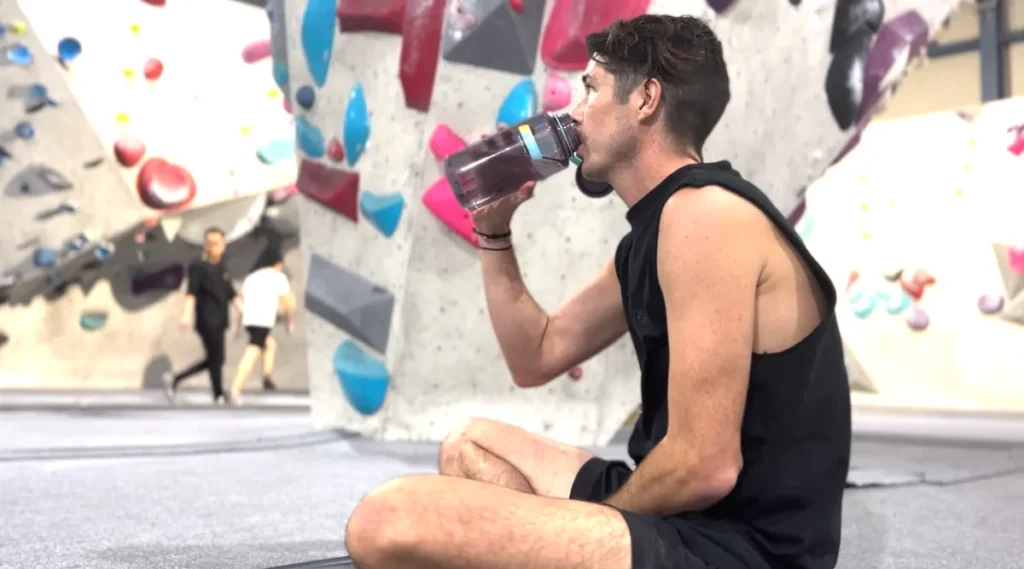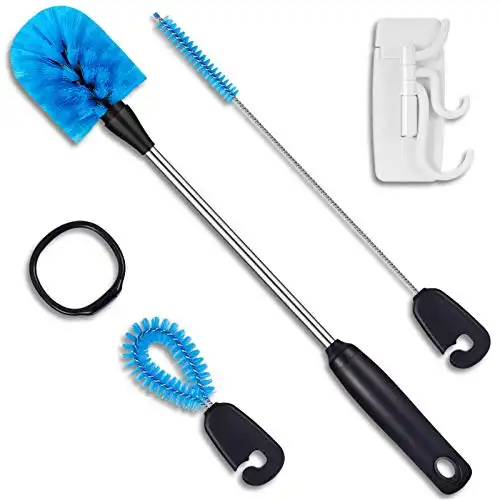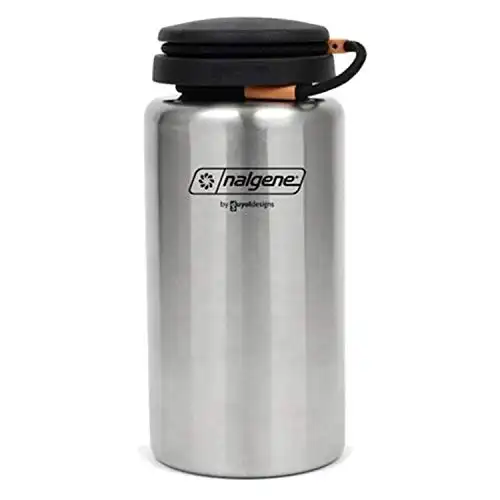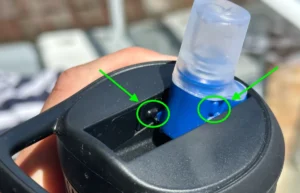My family has been using Nalgene Bottles for years. We love them because they’re inexpensive, durable, and help us drink more water. A bunch of my climbing friends have Nalgene bottles too and swear by them.
But unfortunately, there’s an ongoing debate as to whether or not reusable plastic water bottles, like Nalgene Bottles, are actually safe to drink from.
I want to be as healthy as possible for myself and my kids. So are Nalgene bottles safe to drink out of or should you avoid them?
Since 2008, Nalgene bottles have been made from Eastman Tritan plastic which is considered BPA, BPS and EA-free (free of estrogen mimicking chemicals). They are as safe to drink from as any plastic water bottle can be – at least with the research currently available.
Nalgene Bottles made before 2008 contain BPA and while they are technically still considered safe to drink out of them I would personally avoid them as BPS is know to leach into water and can be harmful for humans.
Newer Nalgene bottles made from Tritan plastic or the Ultralite HDPE bottles are considered safe to drink from and are BPA-free.
However, there’s always the possibility of new evidence coming to light that shows these plastics are dangerous as well. There are already some studies that show even Tritan plastic may leach chemicals, but these studies are small and seem to contain a conflict of interest situation so it's hard to tell what's the truth.
Are Nalgene Bottles BPA-Free?
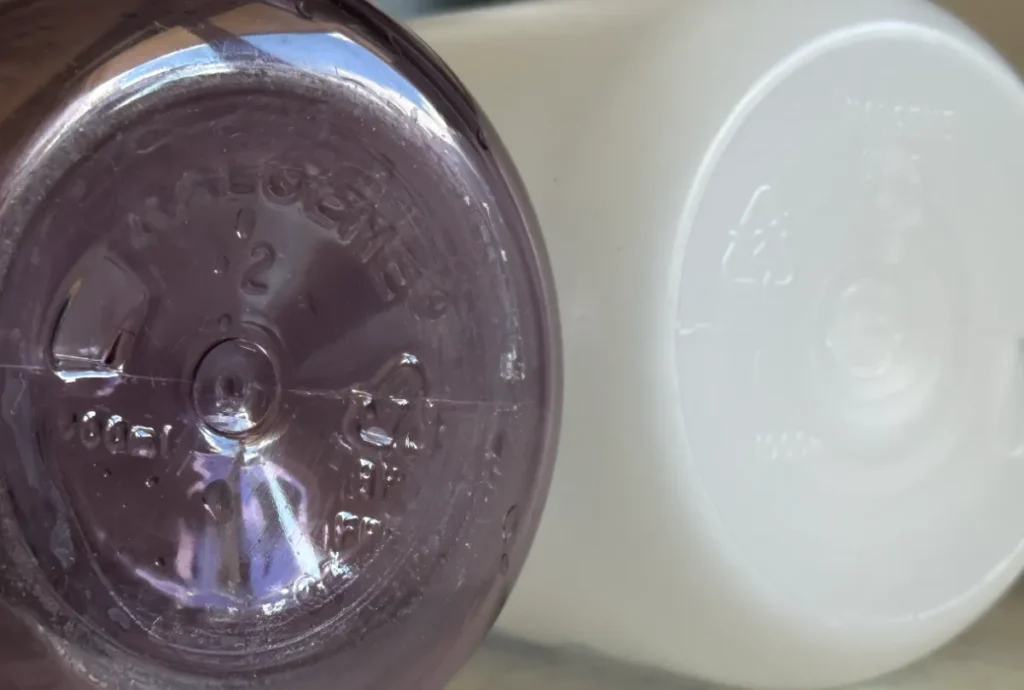
Endocrine disrupting chemicals, or EDCs, are a group of chemicals that affect the way hormones function in the body.
Because our endocrine systems impact so many of our body's functions, EDCs have the potential to cause a wide range of medical problems — from cancer to infertility, and more.
For many years, Nalgene Bottles, along with just about every other hard transparent reusable (or single-use) plastic water bottle, contained bisphenol A (BPA) — a chemical that helps make plastic more resistant to shattering.
Unfortunately, BPA is also an endocrine disruptor.
In 2008, a media firestorm uncovered studies that showed just how damaging BPA is and how easily it can leach from plastic into the food or drink it contains.
Nalgene immediately stopped making their bottles from polycarbonate plastics containing BPA, swapping to HDPE and the specialty plastic, Tritan, made by the Tennessee-based Eastman Chemical.
Many other companies made this same move over the Tritan plastic. Contigo bottles are made from the same plastic as Nalgene bottles and so are many other brands.
According to Eastman, Nalgene Bottles made after 2008 are free of BPA and all other faux-estrogen compounds, like BPS, BPF, and phthalates, that affect the endocrine system or are suspected of having estrogenic or androgenic activity.
Nalgene Bottles made before 2008 contain BPA and I personally wouldn't drink from them. However, many people still do.
If you’re unsure, check the bottom or side of your bottle for a BPA-Free stamp.
Even BPA-Free Plastic Isn’t Perfectly Safe
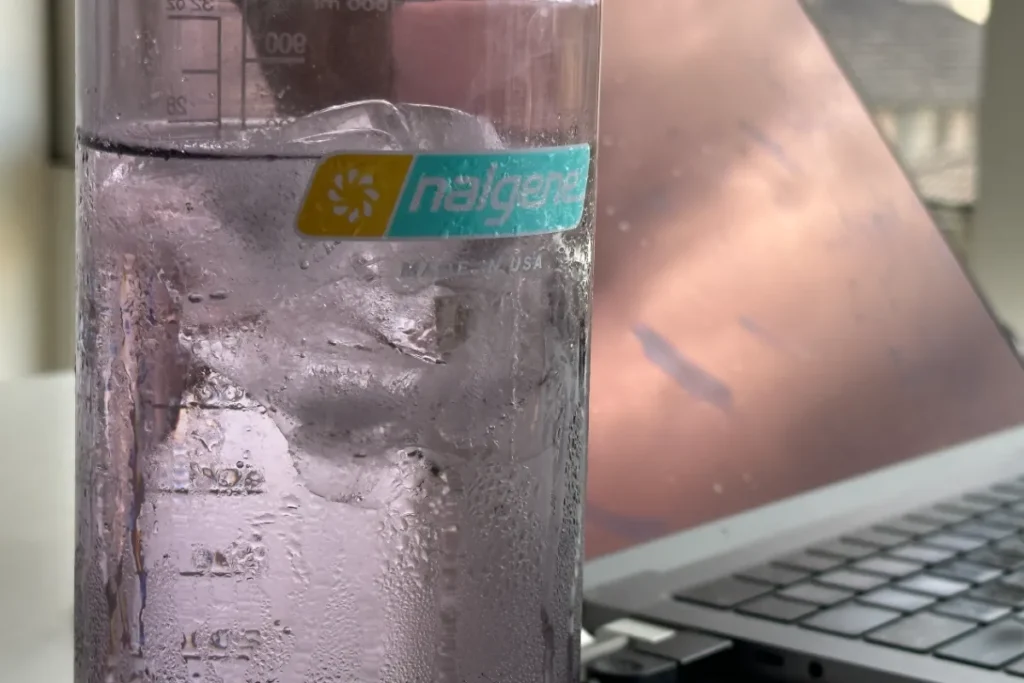
Until 2008, plastics containing BPA were accepted as perfectly safe for food and drink.
Even today, the FDA has only banned BPA in baby bottles despite the growing amount of evidence that it’s harmful.
This is because the US regulatory system considers all chemicals used in manufacturing safe until proven otherwise.
With more than 80,000 of these chemicals being used today, there simply aren’t enough resources available to thoroughly test all of them for safety — which is exactly how the risks of BPA went unnoticed for so long.
Making matters worse, manufacturers don’t have to reveal everything their plastics contain.
According to Eastman and Nalgene, Tritan plastic and HDPE are free from all compounds that have already been identified as unsafe or are suspected highly likely to be unsafe.
But that doesn’t account for all the other chemical compounds found in these plastics that haven’t been so thoroughly tested.
Experts suggest that there are likely hundreds of other compounds found in plastics that are just as harmful, if not more harmful, than BPA.
They just haven’t been identified yet.
BHPF, for example, has been detected in Tritan water bottles and has shown anti-oestrogenic effects in mice in early testing.
Or in this 2019 study that hoped to show people “which plastic types to use and which not [to],” but instead found that “issues of toxicity were widespread — and could be found in nearly every type of plastic.”
So while Nalgene bottles use one of the safest plastics out there, future studies may uncover things we don't yet know – or they may go on to prove that yes these plastics are completely safe to use.
Are Tritan And HDPE Nalgene Bottles Safe To Drink From?
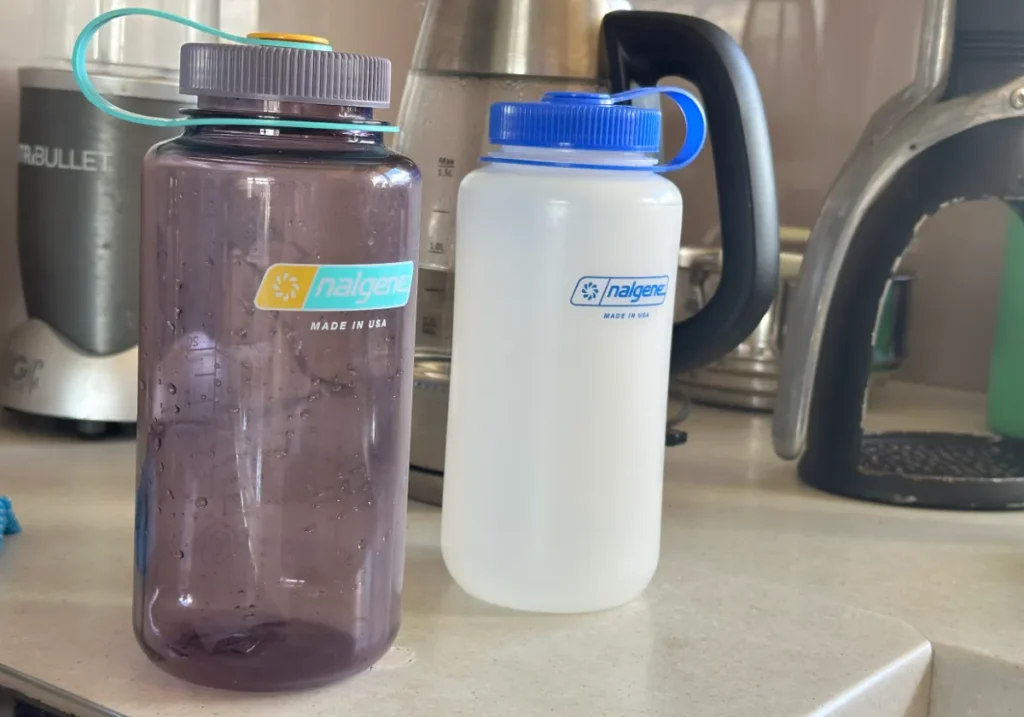
Ultimately, the decision to use Nalgene Bottles comes down to your own personal risk tolerance.
Both Tritan plastic and HDPE have been tested and approved for use with food and drink by the U.S. Food and Drug Administration.
I feel confident using both types of Nalgene bottles where possible but I also use stainless steel and glass bottles whenever I can.
I also take precautionary measures to minimize the potential unknown plastic leaching that could be occurring – I'll share these tips with you in a second.
Just keep in mind, when it comes to plastic, ‘safe’ may mean nothing more than ‘not yet proven dangerous’.
I’ve started moving my family away from plastic water bottles toward safer alternatives, like stainless steel and glass bottles wherever possible. However, we still often drink out of plastic water bottles and I'm not incredibly concerned about it.
I’d just rather be safe than sorry.
How To Make Drinking From A Nalgene Bottle As Safe As Possible
If you're like me and you decide that you’re comfortable with the potential risks of drinking from a plastic water bottle, there are steps you can take to make it as safe as possible.
Watch For Mold
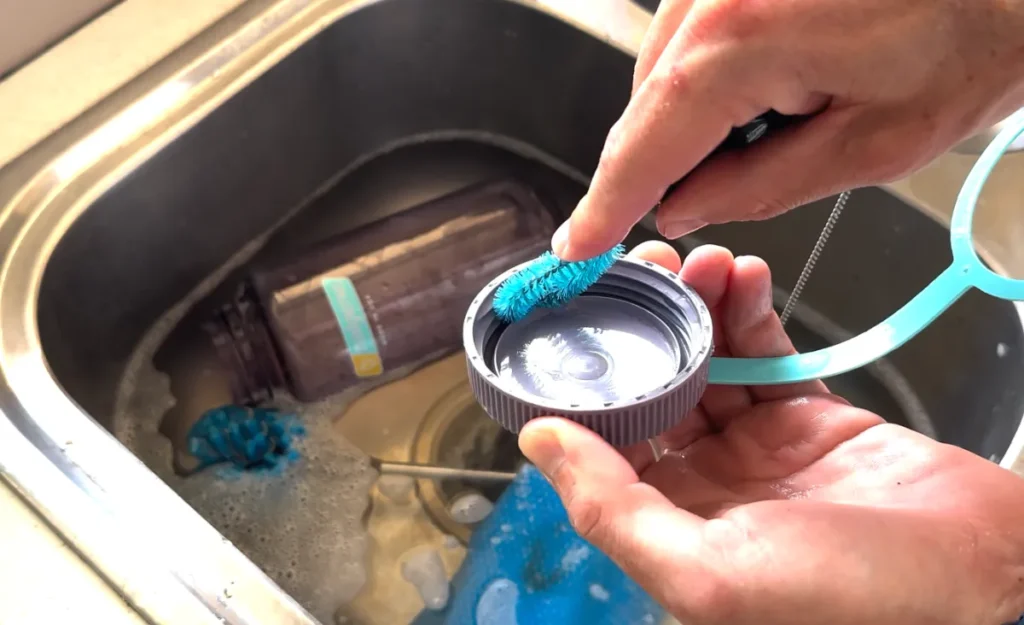
Aside from the dangers of endocrine disruptors and other chemicals leaching into your drinking water, mold growing under the lid of your Nalgene Bottle is a health risk.
Luckily, Nalgene Bottles typically have a pretty simple design — one piece with a simple, screw-on lid. The lid doesn't even typically feature a rubber gasket (which often grow mold) and this makes it easy to keep clean and mold free.
This means there aren’t as many cracks and crevices for mold to hide and washing every nook and cranny is easy compared to many other bottles.
Still, if you’re not washing your Nalgene Bottle often enough or thoroughly enough, the damp, dark lid of a water bottle is the ideal breeding ground for mold.
Ideally, you should wash your Nalgene after every use, or daily if you’re refilling it throughout the day. If you’re only drinking water, every couple of days is probably good enough.
Just make sure to check for mold under the lid and on the threads, where it’s most likely to grow.
You can kill mold with a mixture of distilled white vinegar and baking soda. A toothbrush can be used to scrub the threads and tight spaces under the lid or I have this affordable bottle cleaning kit (from Amazon) with a bottle brush, straw cleaner and smaller brush perfect for scrubbing the inside of the lid.
Three tools in one. Includes a long bottle brush, straw brush and detail cleaner (great for cleaning inside lid gaskets). Comes with organizer ring and storage hook,
Thoroughly Wash New Nalgene Bottles
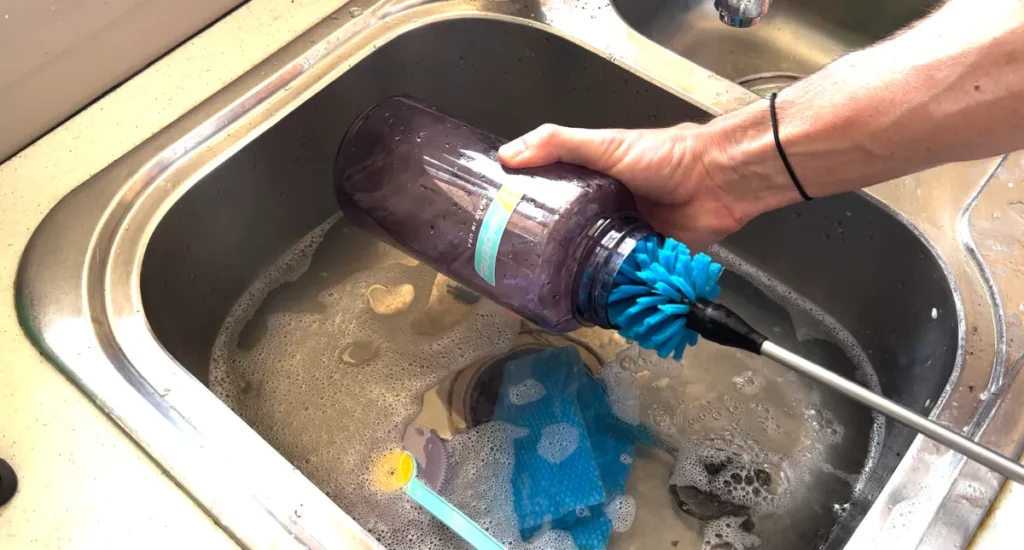
Although modern Nalgene Bottles are BPA and EA-free, a 2021 study found that new bottles made of Tritan plastic sometimes contain residual BPA — likely from being manufactured in the same plant as plastics that contain BPA.
The study tested multiple washing methods to see which was able to remove BPA most efficiently.
Running the bottle through multiple cycles in a dishwasher was the most effective. Tritan plastic is dishwasher safe so this can be a good way to clean them.
Unfortunately, dishwashing reusable plastic bottles may present other dangers “because machine washing wears down the plastic and thereby increases leaching.”
Usually I opt for multiple hand cleaning before I use a brand new Nalgene bottle.
Don’t Drink Hot Water From A Nalgene Bottle
Avoid putting hot or boiling water in your plastic Nalgene Bottle — heat increases the chances that chemicals will leach from plastic into the water it contains.
I'll still occassionally put hot water inside my Nalgene bottle to use it as a hot water bottle and way to keep me warm when I'm backpacking or camping. However, I now won't drink this water.
I'll discard it after it's cooled down and I'll then rinse out or wash my bottle before refilling it with fresh cold water. Here's how I use boiling water in my Nalgene bottle.
Stainless Steel Nalgene Bottles offer a safe alternative for use with hot water as they won't leach harmful endocrine disruptors.
Made from single wall surgical grade 316 (18/10) stainless steel and featuring the same size threads as the regular Nalgene widemouth this is the perfect bottle for those wanting the lifetime warranty and durability of a Nalgene without the plastic.
Comes with a rope pack loop lid attachment.
Don't Keep Water In The Bottle For Long
When I was younger I used to fill up a water bottle and it might take me 2-3 days to finishing drinking it.
Now if I fill up my water bottle I'll either drink the water in a couple of hours or I'll discard the water and refill it with fresh water.
The longer water sits in your water bottle the more likely it is to contain leached chemicals (plus grow harmful bacteria).
Just to be safe I regularly empty out my Nalgene and replace the water when I haven't fully drunk the bottle and I won't drink old water from it.
Replace Old Worn Out Nalgene Bottles
Nalgene Bottles have a reputation for lasting for a really long time. But unfortunately, as plastic ages, scratches and scuffs may cause more chemicals to leach into your water.
Replace your Nalgene if the inside of the bottle is scratched, rough, or otherwise damaged.
Retired Nalgene bottles have a variety of other uses so don't throw them out. Here are some ideas of cool things you can do with old Nalgene water bottles.

